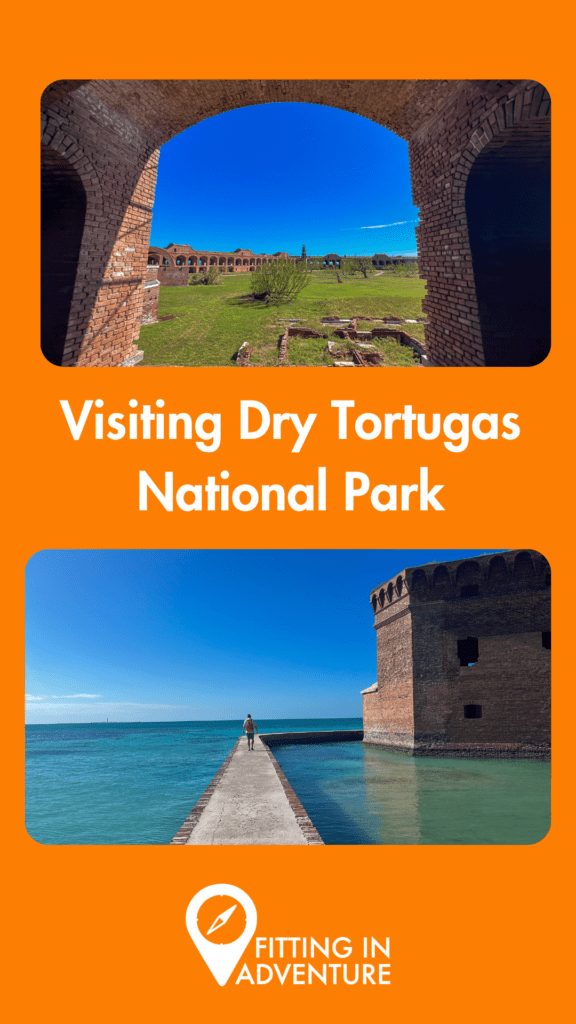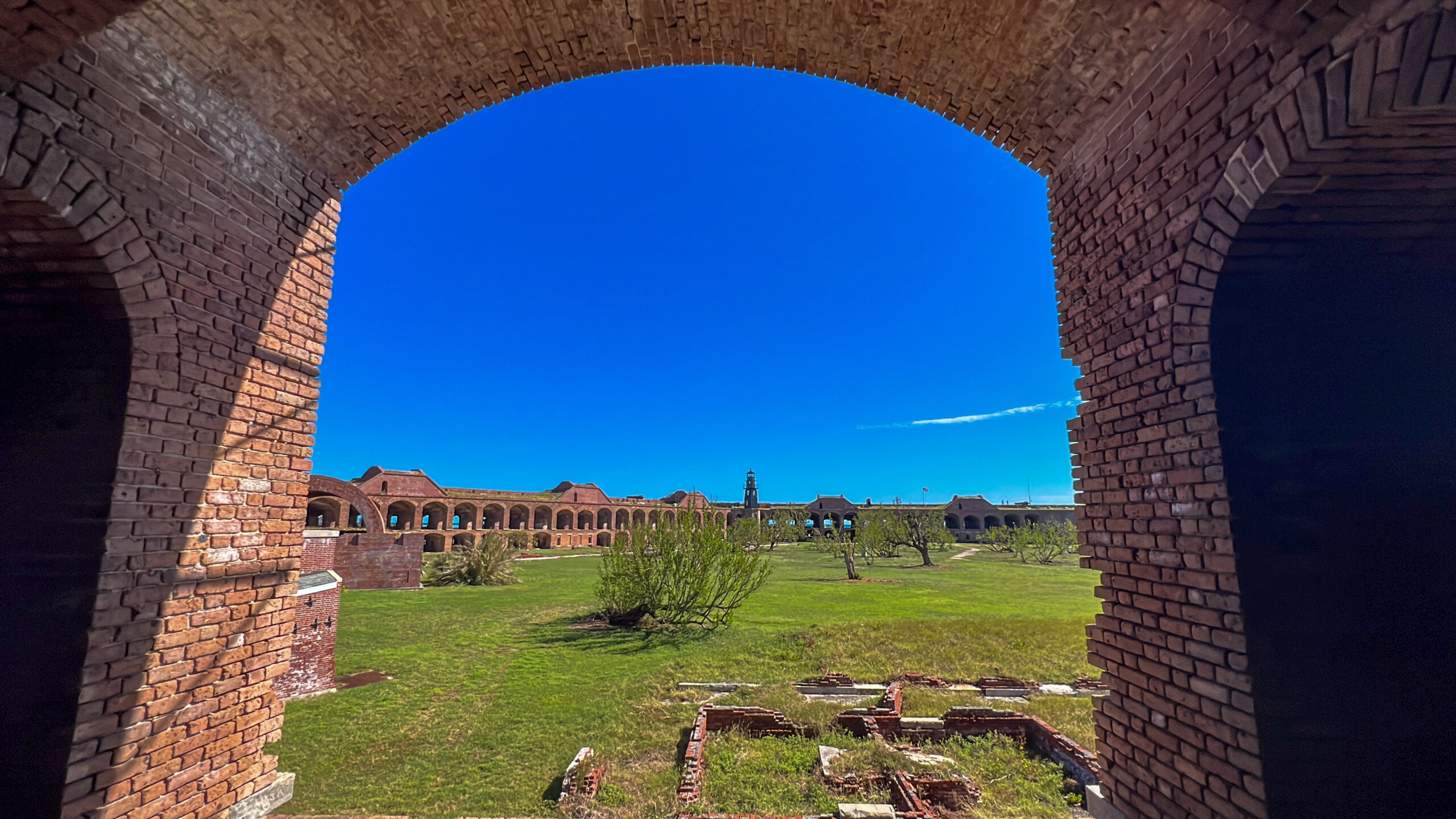Many might not know this, but the Florida Keys don’t stop at Key West. The island chain extends another 70 miles into the Gulf of Mexico. And at the westernmost end of the island chain sits Fort Jefferson. There is an uninhabited island 3 miles farther west called Loggerhead Key, the true end of the Keys. This island houses the Dry Tortugas Light. Or as it’s more commonly called the Loggerhead Lighthouse. It’s said to be a greater distance from the mainland than any other lighthouse in the world. This small group of islands is now known for its clear waters. Abundant marine life. Birdwatching, and snorkeling. But Fort Jefferson once protected one of the world’s busiest shipping lanes.
Disclosure: Some links on our site are affiliate links. If you purchase a linked item, we will make a commission, at no extra charge to you.
History of Fort Jefferson
The islands were first discovered by Juan Ponce de León in 1513. He named them Las Tortugas (Spanish for the tortoises). After the large number of sea turtles, he found there. Later, mariners added the adjective dry because of the lack of fresh water. The islands immediately became a strategic location for Spanish explorers traveling Florida’s Gulf Coast. They used them as navigational markers. Telling them when they should start turning into the Gulf from the Atlantic Ocean. This was important to navigators because of the coral reef. The Florida Keys Reef Tract is the third-largest barrier reef in the world. The reef is responsible for one of the richest concentrations of shipwrecks in North America. According to the NOAA, over 200 shipwrecks are estimated to be scattered around this area. The first documented was in 1622. The Spanish ship Nuestra Senora de Rosario went down in a hurricane while en route from Cuba to Spain. The islands were also used during this time as a base of attack for pirates preying on merchant ships in the Gulf. One of these pirates, Jean Lafitte, would later aid General Andrew Jackson in his defense of New Orleans.
In 1819, the United States acquired Florida from Spain. Afterward, construction began on two lighthouses. The first was operational in 1826. The conical brick tower and its outbuildings were the only structures on Garden Key. Until construction started on Fort Jefferson, in 1846. In 1858, Loggerhead Lighthouse was built. The importance of Dry Tortugas was long known. Whoever controlled these islands, controlled the Florida Straits. The 75-mile wide main shipping channel. Between the Gulf of Mexico, the western Caribbean, and the Atlantic. Fort Jefferson would serve to protect not only one of the world’s busiest shipping lanes. But one of the most strategic deep-water anchorages in North America. With the fortification of this harbor, the US maintained an important “advance post” for ships patrolling these waters. The harbor provided ships the chance to refit, resupply, or seek refuge from storms. Passing ships could avoid Fort Jefferson’s guns. But they couldn’t avoid the warships that anchored in its harbor.
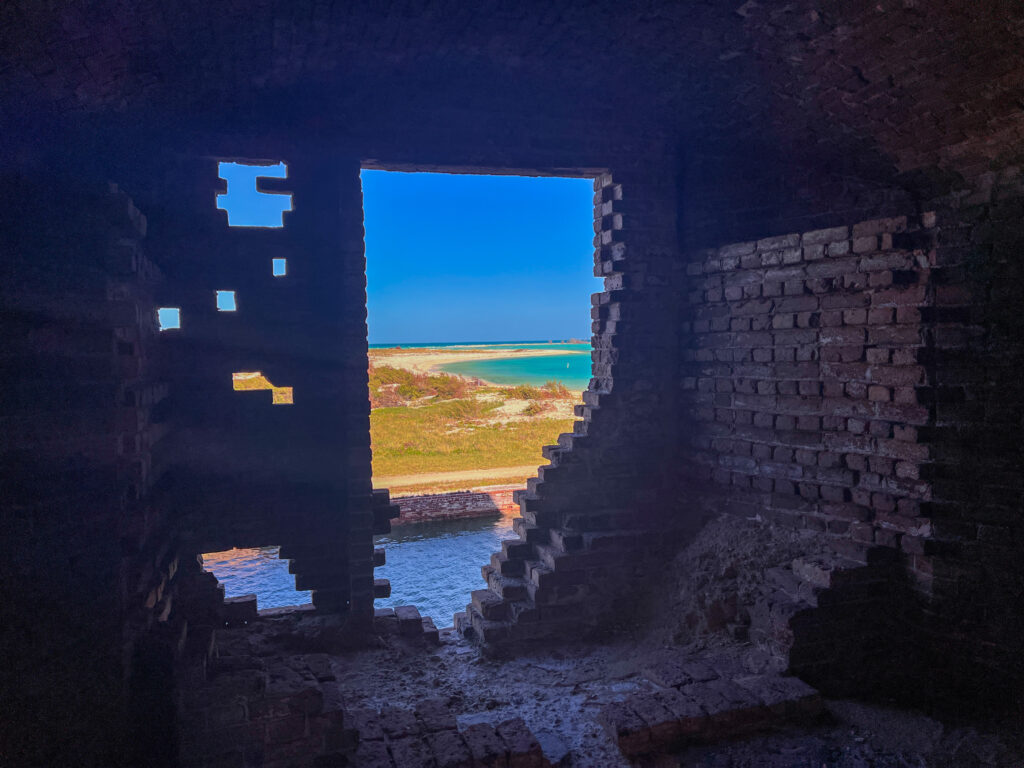
The fort itself was a three-tiered, six-sided masonry building. It’s constructed of over 16 million bricks and covers 16 acres. It is the largest masonry structure in America. As large as it is, it was actually never finished. Work stopped in 1874 when everyone left and it was officially abandoned. One reason for the stoppage was fear that the weight of additional bricks and cannon would cause further settling. Placing more stress than the structure and the cistern system beneath it could handle. And while technically built as a massive military fort, it never saw battle. Nor was it ever engaged in any military operation. Although it did serve as a prison during the Civil War. Housing such infamous criminals as Dr. Samuel Mudd, Samuel Arnold, Michael O’Laughlen, and Edmund Spangler. All were convicted in the conspiracy to assassinate President Lincoln.
While the Army officially abandoned it in 1874, it was still under their control. But by 1888, the cost of maintaining it could no longer be justified. It was then turned over to the Marine Hospital Service to be used as a quarantine station. Besides quarantine, it served as a hospital for those wounded in the Spanish-American War.
It also saw service as a coaling station. Warships would stop and take on coal for their boilers. In 1898, the USS Maine sailed out of the Dry Tortugas and into history. Fort Jefferson was her last stop before that fateful mission in Havana, Cuba.
From Military Fort to Monument: Dry Tortugas National Monument
In 1908, President Theodore Roosevelt declared the islands the “Dry Tortugas Keys Reservation”. Creating a wildlife refuge to protect nesting birds from egg collectors.
It saw limited use during WWI as a radio transfer station and a seaplane base. Its harbor was once again used during WWII for defensive torpedo boats. Minesweepers and convoy escort vessels also anchored in the harbor. But by this point, it was obvious the fort’s usefulness was fading into history.
During his time in Key West, Ernest Hemingway indulged his passion for sport fishing. Making several extended fishing trips in and around the Keys, Hemingway and his “Mob” dined on snapper and yellowtail. They ate raw conch salad and spent many a night docked in the Marquesas. But one trip, in particular, didn’t go as planned. Initially planned for a week, a strong tropical storm blew in and marooned the “Mob” at Fort Jefferson for 17 days. They survived off their supply of canned goods, coffee, and liquor for most of the days. But by the end, they relied solely on fish before they could safely return to Key West.
President Franklin Roosevelt designated the Dry Tortugas as the Fort Jefferson National Monument, in 1935. In 1983, the National Monument was expanded. Then, on October 26, 1992, it was redesignated as a National Park. It is one of America’s most remote and least visited National Parks. The park was established to protect the island and marine ecosystems of the Dry Tortugas. To preserve Fort Jefferson and submerged cultural resources such as shipwrecks. And to allow for public access in a regulated manner.
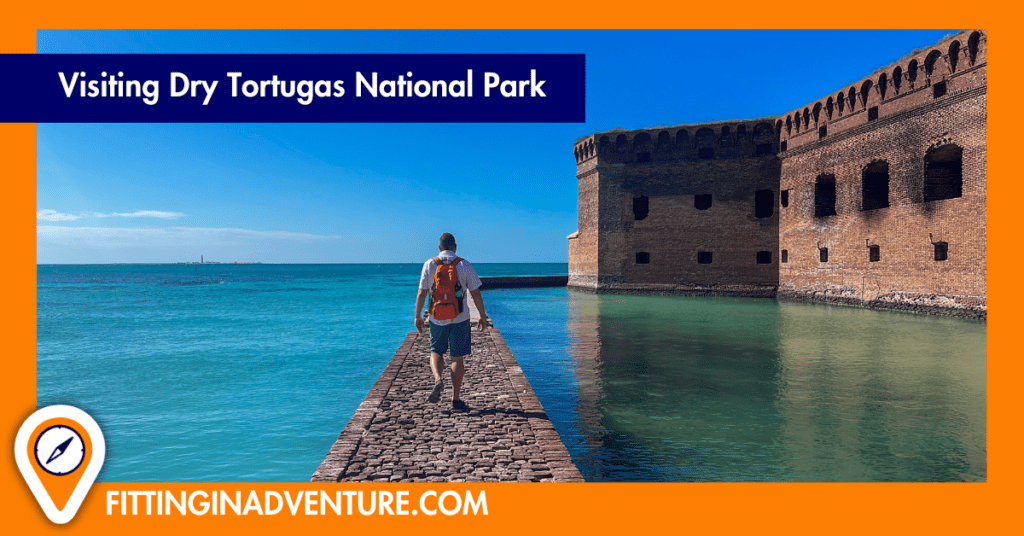
Visiting Dry Tortugas National Park
Today, Dry Tortugas is a popular destination for adventure. You can tour the fort on a 45-60-minute guided tour. Or download a self-guided tour to experience it on your own. But be sure to download it before you arrive, as there is no cell service in the park. As you explore this marvel of engineering, imagine what it was like during the 1800s. Remember, every single brick, board, and building material was brought by ship from the mainland. See if you can spot the different colored bricks. The yellow bricks came from Pensacola before the Civil War. After the war started, bricks came from Maine. These are red in color.
Maybe you just want to stroll along the beach. You can do that, too. There are four beaches for you; North Swim Beach, Seaplane Beach, Dinghy Beach, and South Swim Beach. Get your feet wet in the crystal blue water. Relax under the swaying palm trees. Or sunbathe on the soft sand.
Do you enjoy snorkeling? Here you’ll find some of the best snorkeling in North America. And with the depth of the water between 5 and 15 feet, it’s good for any skill level. Dive among the colorful tropical fish living among the coral. Their vivid reds, yellows, greens, and blues work as camouflage in the reef as they hide from predatory fish. Some of these are amberjacks, grouper, tarpon, and wahoos. And at the top of the pyramid, barracuda and sharks. If you’re lucky, maybe you’ll see one of the three main species of tortoises; green, loggerhead, and hawksbill. But please remember, you can look, but do not disturb any of the marine life you encounter.
As you swim among the reef, it is very important to not touch or handle the coral, itself, though. This is a very delicate ecosystem and handling the coral may make it susceptible to damage or disease.
The Dry Tortugas is also a vital stop for birds migrating between North and South America. Over three hundred species have been spotted on the islands. It is said that Spring is the best time for bird watching, but every season offers you the chance to see something.
Maybe your trip to Fort Jefferson and the Dry Tortugas can’t be accomplished in one day. That’s fine. You can camp on Garden Key, the Key where Fort Jefferson actually is built. You will be treated to all the amazing things mentioned above. But you can add incredible sunsets and sunrises to the list. But these campsites are very primitive. The Key has very little in facilities for overnight guests. Everything you want or need during your stay will have to be brought by you. That includes all of the water you will need. And all of your trash must be carried out by you after your stay. Also, there is no wi-fi, cell service, or electricity on the island. Anything you want to power will need to be battery-operated. There are composting toilets for your use but are closed daily from 10 am to 3 pm. You will need to use the public toilets on the ferry during this time. There is too much to cover here regarding camping and transportation to the island. For more information, be sure to check out the National Park website for camping in the Dry Tortugas.
Getting to Dry Tortugas National Park
As for transportation for your day trip, there are two main ways to get there. The Yankee Freedom Ferry and Key West Seaplane Charters. If you own your own boat, you may take it there, too. But again, be sure to check with the National Park regarding anchorage and permits.
The Yankee Freedom is the only ferry authorized by the National Park Service to take you to Fort Jefferson. The ferry is a state-of-the-art aluminum catamaran that can travel at 30 mph. Making it the fastest ship of her size out of Key West. The trip will take approximately 2 hrs 30 mins each way. But you will be traveling in comfort. The upper deck has spacious open-air seating to enjoy the sunshine and views. A covered cocktail bar is there, too. But it is open only on the return trip. The large main cabin is fully air-conditioned with cushioned seating. DVD monitors entertain you during the trip. A full galley has snacks, film, souvenirs, and alcoholic beverages (for the return trip). There are three bathrooms and nine freshwater rinse showers for use, as well. The ferry makes one trip out in the morning and its return trip in the afternoon. So be prepared to spend the entire day on Fort Jefferson.
We chose to take the seaplane for our adventure. Key West Seaplane Charters offers both half and full-day trips. Like the Yankee Freedom, Key West Seaplane Charters is the only authorized charter flight to the island. It is more expensive than the ferry and seating is limited. The plane ride takes about 40 minutes. You take off from Key West International Airport and head 70 miles west towards the islands. The flight provides a vantage point of Key West locations you may have only seen from ground level. Everyone on the flight has a window seat and a headset as the plane only has five seats per side.
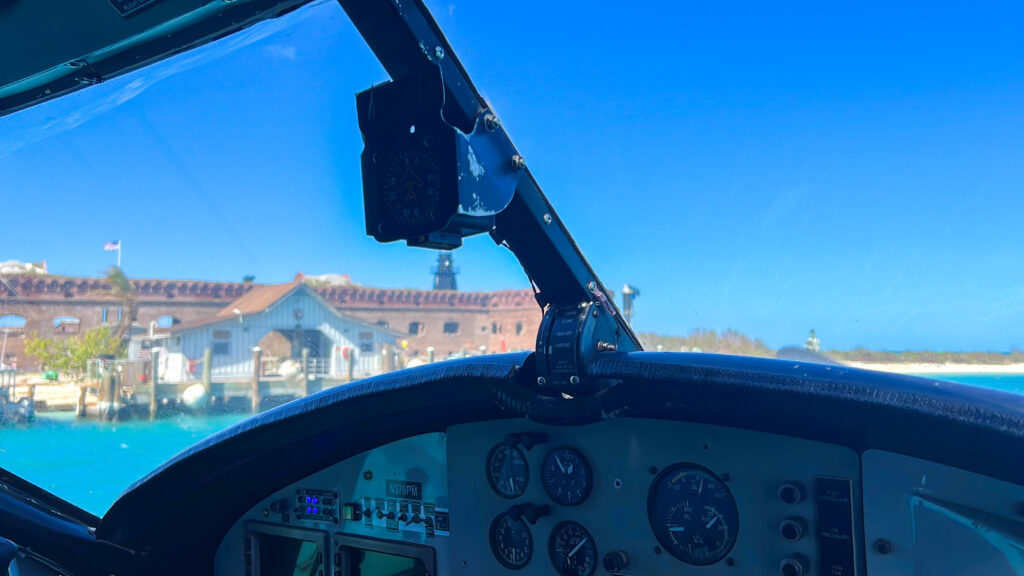
Shortly after leaving Key West, we fly over an area called the “Flats”. This area is part of the National Marine Sanctuary and extends almost 20 miles. The water is very shallow at only 3-5 feet. Looking out the windows, we see numerous uninhabited mangrove islands. One island, Ballast Key, is the only privately owned island in the Sanctuary and has a private house. In the late 70s and early 80s, Tennessee Williams painted here while visiting the owners. In the early 70’s, Jimmy Buffett and other Key West regulars would come out here to relax and party. Shortly after passing the Flats, we fly over the Marquesas Keys. These coral islands form a coral atoll. An atoll is a ring-shaped coral reef, island, or series of islets. An atoll surrounds a body of water called a lagoon. Sometimes, atolls and lagoons protect a central island. Channels between islets connect a lagoon to the open ocean or sea. Just beyond the Marquesas lies the “Quicksands”. This vast underwater desert is made up of huge sand dunes continually moved by the tidal currents, making for notoriously rough conditions. It’s here that Treasure Hunter Mel Fisher found the Spanish Galleons “Atocha” and “Margarita”. Over a half billion dollars worth of gold and silver were spread across an 8-mile area. We see two other shipwrecks in this area. The first is the World War II Destroyer Escort, the “Patricia”. She was sunk by the Navy for bombing practice. All that’s left of her now is the shape of a ship 30 feet below the surface. Next is the “Artubus”. One of Mel Fisher’s dive boats, it sank because of the deterioration of the hull. Luckily, there was no loss of life.
As you look out the windows, make sure you keep an eye out for marine life such as turtles, manta rays, dolphins, and sharks. The entire flight is just about 500 feet in altitude, so your view of everything is amazing. As we bank to come in for landing, Fort Jefferson appears outside the right side of the plane. Be sure to have your camera ready for the shot. To quote Jimmy Buffet, “we landed in the water, just about my favorite thrill”. We spent a few hours on the island before leaving. As we taxied out into deeper water, we again are greeted with a spectacular view. And as we lift off, those seated on the left side this time, get the final view of Fort Jefferson. As we land back at Key West International Airport, we are both tired and excited after our time in the Dry Tortugas National Park.

The best time to visit the Dry Tortugas will depend on several factors, including your plans and the weather. Peak tourism is between mid-December and mid-April. When the weather is warm and the water clear. This is the best time for snorkeling and diving. The summer months are very hot and humid. With temperatures reaching 90°F or higher. Hurricane season starts in June and runs through November, so visitors should always check the weather.
Our National Park Service protects and preserves the natural and cultural resources of our country for the education and enjoyment of current and future generations. Park Service employees, with the help of volunteers and partners, safeguard the special places and share their stories with nearly 320 million visitors every year. Be sure to get outside and visit the parks near you. Learn the stories of the people and places that shaped our nation. And fit some adventure into your life.
Check out our video on the Dry Tortugas below.
(Don’t forget to subscribe for future adventures.)
